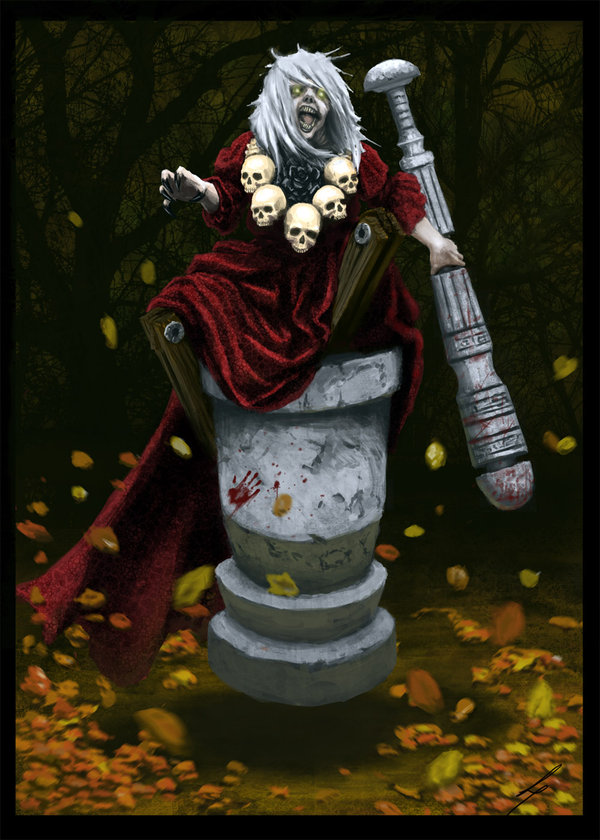
Baba Yaga Baba Yaga TShirt TeePublic
Baba Yaga is the primary antagonist in the fantasy novel Enchantment by Orson Scott Card,. In this case, both characters are symbols for the different phases of life. Baba Yaga has also made several appearances in the Dungeons & Dragons fantasy role-playing game. Notes.

A. Chirkov, Fedoskino Lacquer Box, Baba Yaga Baba yaga, Russian folk
8 Selfish Witch Leaves Away From The Civilization. A Slavic witch, or Baba Yaga, rejects what society expects of her. She lives away from civilization in the woods and even rejects society herself. A Slavic witch serves as a reminder to those who wander into the woods. If you go too deep into the woods, Baba Yaga will eat you.

Pin on sayings
Baba Yaga depicted in Tales of the Russian People (published by V. A. Gatsuk in Moscow in 1894) Baba Yaga being used as an example for the Cyrillic letter Б, in Alexandre Benois' ABC-Book. Baba Yaga is an enigmatic or ambiguous character from Slavic folklore (or one of a trio of sisters of the same name) who has two opposite roles. In some motifs she is described as a repulsive or ferocious.

Baba Yaga Baba yaga, Baba yaga house, Fairytale illustration
Main themes of Russian folklore include the journey of the hero, the triumph of kindness and humble attitude over the clergy's arrogance, and the dual nature of Baba Yaga, who initially symbolized Mother Nature but was depicted by Christians as a scary creature. Main characters of Russian folktales are Baba Yaga, Ivan The Fool or Ivan The.

Baba Yaga Children's Book Illustration on Behance
Baba Yaga dwells in an enchanted hut that stands on chicken legs, which allows it to move and navigate through the dense forests and treacherous landscapes of Slavic lands. The hut is a place of bewilderment and enchantment, its walls adorned with strange symbols and charms that guard the secrets within.

Baba Yaga Children's Book Illustration on Behance
Baba Yaga may well be the most ancient being in Russian folklore. So much so that linguists still debate the origins of the name. In Russian, "baba" is the noun for "woman". However, in Indo-European languages, "baba" is a progenitor. Indeed, numerous stone sculptures in Southern Russia have been found to depict such a female.

Goddess Baba Yaga Journeying to the Goddess
Despite being a negative figure in many stories, Baba Yaga is also seen as a symbol of strength, wisdom, and independence for women. Her character has inspired many modern works of fiction, including video games, animated films, and music. In conclusion, Baba Yaga is an important figure in Slavic mythology and Polish culture.

Legend and Folklore Symbols Old Baba Book of shadows, Legends and
Baba Yaga ( pronounced: / b ɑː b ɑː ˈ j ɑː g ə / ba-ba YA-guh) was an extraordinarily powerful mage and archfey. Some described her as the most powerful female mage ever known, a sorceress with a reputation for passing throughout the planes. In doing so, her magical hut also appeared elsewhere, and was reported to have arrived on Faerûn.

Wonderful World of Wappies » Blog Archive » Vasilisa The Beautiful
Baba Yaga, known as a terrifying old woman, is a prominent figure in Slavic folklore. She is depicted as a deformed and voracious creature who kidnaps and consumes her victims, particularly children. However, Baba Yaga's significance goes beyond her malevolent nature. She possesses a complex duality, often challenging those who encounter her.

Baba Yaga, a folklore character from Russian fairy tales. Drawn in
Baba Yaga's house is generally believed to be situated in a deep, dark forest. The house, which sits atop two giant chicken legs, is said to spin on a constant basis. It only stops to allow someone in when a magical phrase is used. Baba Yaga's door can only be revealed a magical phrase is said.

Painting Inspiration, Art Inspo, Framed Wall Art, Framed Art Prints
Baba Yaga - Ježibaba. Whilst the word Ježibaba loosely translates to 'crone', the folklore figure associated with this character is more commonly known as Baba Yaga, a famous legend in herself. A well-known figure in Slavic/Russian folklore, Baba Yaga is one of a trio of ferocious witches, and usually is of ambiguous morality, following.

Baba Yaga by Victor Sukhochev on Dribbble
"The essence of Baba Yaga exists in many cultures and many stories, and symbolizes the unpredictable and untamable nature of the female spirit, of Mother Earth, and the relationship of women to the wild," explained Ryan, the editor of the collection, in an interview with the BBC.. "She's a shamanic trickster, a category and boundary-crosser, a [reminder] that freedom lies a little beyond.

BEHOLD the baba yaga hand of glory and divination!! all will be
Laundering the Baba Yaga's clothes is a fabulous symbol. In the old countries, and still today, in order to launder one's clothes one descends to the river, and there makes the ritualistic ablutions that people have made since the beginning of time in order to renew the cloth. This is a very fine symbol for a cleansing and purification of.

Baba yaga by Monanu on deviantART Baba yaga, Slavic folklore, Slavic
A Baba Yaga Story of Initiation into the Magical Arts (aka Vasalisa the Wise) One of the more famous of the Baba Yaga stories features the main character not as the old woman herself but a young maiden named Vasalisa. In the tale of Baba Yaga and Vasalisa the Wise, Baba takes on her typical personality as the fearsome witch in the wood.

Baba Yaga John Wick Wallpaper KoLPaPer Awesome Free HD Wallpapers
Baba Yaga, in Slavic folklore, an ogress who steals, cooks, and eats her victims, usually children.A guardian of the fountains of the water of life, she lives with two or three sisters (all known as Baba Yaga) in a forest hut that spins continually on birds' legs.Her fence is topped with human skulls. Baba Yaga can ride through the air—in an iron kettle or in a mortar that she drives with.

"Baba Yaga" Sticker for Sale by agafuta Redbubble
Baba Yaga appears in many Slavic and especially Russian folk tales, with the earliest recorded written mention of her coming in 1755, as part of a discourse on Slavic folk figures in Mikhail V.